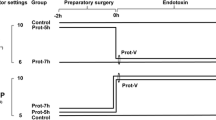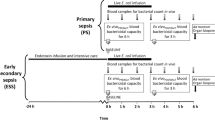Abstract
Background:
Carbon dioxide (CO2) pneumoperitoneum alters the inflammatory response in animal models of sepsis. The spleen is a key organ in inflammation and its removal was predicted to modify this effect.
Methods:
The acute phase inflammatory response to lipopolysaccharide (LPS) challenge in male rats was examined for the effects of splenectomy (spx) and the technique of removal (open or laparpscopic). A series of experiments compared LPS-only controls with LPS injection 2 or 9 days following open spx, lap CO2 spx, open sham, or lap CO2 sham. The method of splenectomy was studied by randomization to control, open spx, lap CO2 spx, lap helium (He) spx, or lap air spx with LPS challenge on postoperative day 2. Serum levels of tumor necrosis factor-α (TNF-α), interferon-γ (INF-γ) and, interleutin (IL) 10 were collected at multiple time points, assayed by commercial enzyme-linked immunosorbent assay, analyzed by analysis of variance.
Results:
Levels of TNF-α at 1.5 were significantly lower following open sham than following lap sham (p < 0.05). Splenectomy drastically reduced INF-γ and TNF-α levels compared to controls (p < 0.05) on postoperative day 2. No method of spx preserved TNF-α or INF-γ responses. Recovery of TNF-α response on day 9 was delayed in the spx groups.
Conclusions:
Splenectomy dramatically reduces TNF-α and INF-γ responses to LPS challenge, although by different mechanisms. Pneumoperitoneum-mediated modulation of the septic inflammatory response is partially dependent on the spleen.




Similar content being viewed by others
References
Are C, Talamini MA, Murata K, DeMaio A (2002) Carbon dioxide pneumoperitoneum alters acute-phase response induced by lipopolysaccharide. 16: 1464–1467
Bachman SL, Hanly EJ Nwanko JI, Lamb J, Herring AE, Mahron A, De Maio A, Talamini MA (2005) The effect of timing of pneumoperitoneum on the inflammatory response. Surg Endosc in press
Baumann H, Gauldie J (1990) Regulation of hepatic acute phase plasma protein genes by hepatocyte Stimulating factor and other mediators of inflammation Mol Biol Med. 7: 147–159
Billiar TR, West MA, Hyland BJ, Simmons RL (1988) Splenectomy alters Kupffer cell response to endotoxin Arch surg 123: 327–331
Deriy LV, Beno DW, Uhing MR, Jiyamapa-Serna VA, Kimura R (2002) Splenectomy ablates endotoxin-induced INF-γ response in rats Shock 17: 312–315
Doherty GM, Lange JR, Langstein HN, Alexander HR, Buresh CM, Norton JA (1992) Evidence for INF-γ as a mediator of the lethality of endotoxin and tumor necrosis factor J Immunol 149: 1666–1670
Esguerra LEO, Beno DWA, Deriy L, Kimura RE, Uhing MR (2000) The effect of surgical stress on the endotoxin-induced interferon-g response Shock 14: 561–564
Gitzelmann CA, Mendoza Sagaon M, Talamini MA, Ahmad S, Pegoli W, Paidas CN (2000) Cell-mediated immune response is better preserved by laparoscopy than laparotomy Surgery 127: 65–71
Hanly EJ, Mendoza-Sagaon M, Murata K, Hardacre JM, DeMaio A, Ta1amini MA (2003) CO2 pneumoperitoneum is responsible for inflammatory response reduction following laparoscopically induced sepsis Ann Surg 237: 343–350
Heinzel FP, (1990) The role of INF-γ in the pathology of experimental endotoxemia J Immunol 145: 2920–2924
Kohno H, Yamamoto M, limuro Y, Fujii H, Matsumoto Y (1997) The role of splenic macrophages in plasma tumor necrosis factor levels in endotoxemia Eur Surg Res 29: 176–186
McCarthy JE, Redmond PH, Duggan SM, Watson RWG, Condron CM, O’Donnell JR, Bouchier-Hayes DJ (1995) Characterization of the defects in murine peritoneal macrophage function in the early postsplenectomy period J Immunol 155: 387–396
Oberholzer A, Oberholzer C, Moldawer LL (2000) Cytokine signalling—regulation of the immune response in normal and critically ill states Crit Care Med 28: N3–N12
Oberholzer A, Oberholzer C, Moldawer LL (2002) Interleukin-10: a complex-role in the pathogenesis of sepsis syndromes and its potential as an anti-inflammatory drug Crit Care Med 30: S58–S63
Richter S, Olinger A, Hildebrant U, Menger MD, Vollamr B (2001) Loss of physiologic hepatic blood flow control (hepatic arterial buffer response) during CO2 pneumoperitoneum in the rat Anesth Analg 93: 872–877
Targarona EM, Espert JJ, Bombuy E, Trias M (1999) Laparascopic splenectomy in a rat model; developing an easy technique J Laparoendosc Adv Surg Tech A 9: 503–506
West MA, Baker J, Bellingham J (1996) Kinetics of decreased LPS-stimulated cytokine release by macrophages exposed to CO2 J Surg Res 63: 269–274
Acknowledgment
This project was funded by a SAGES endoscopic/laparoscopic research award.
Author information
Authors and Affiliations
Corresponding author
Rights and permissions
About this article
Cite this article
Bachman, S.L., Hanly, E.J., Saad, D. et al. The role of the spleen in laparoscopy-associated inflammatory response. Surg Endosc 19, 1035–1044 (2005). https://doi.org/10.1007/s00464-004-8820-2
Received:
Accepted:
Issue Date:
DOI: https://doi.org/10.1007/s00464-004-8820-2




